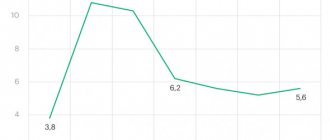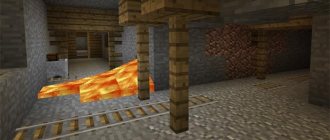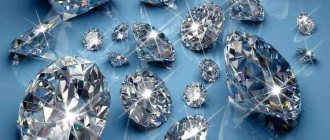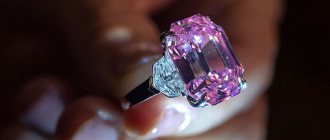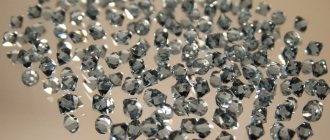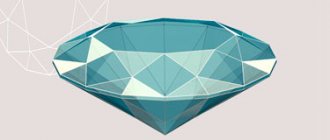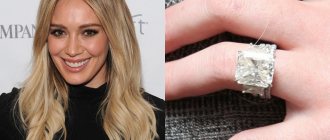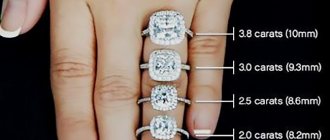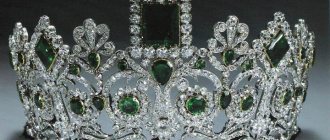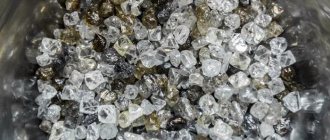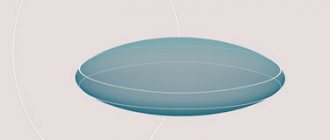Diamond is the most expensive mineral in the world. Stones are even sold at auctions before falling into the hands of jewelers. But processed diamonds can be purchased on the stock exchange, and this is something that private individuals rarely afford; rather, jewelry companies do the purchasing. But ordinary people are also interested in the question of how much a diamond costs. Information is needed in order to compare the initial cost of the stone with the final price of the jewelry.
Cut diamonds
Precious embryo
At its core, diamond is carbon, just like the graphite in a pencil.
The hardest (not to be confused with the most durable) mineral on the planet. During the formation of our Earth, when magma splashed onto the surface, at high temperature and pressure, graphite turned into crystals, which we know as diamonds. These deposits in which diamonds are found are called kimberlite deposits; they are found on all continents (perhaps Antarctica remains the exception). The proven age of the oldest diamond is over one billion years. In general, their age is hundreds of millions of years. The process of extracting stones is as follows. First, geological exploration is carried out and the locations of possible deposits are determined. Next, soil samples are taken and the diamond content in the rock is determined. If the content of gem-quality diamonds in a deposit exceeds 2 carats (0.4 grams) per ton of rock, then the mining project is considered economically feasible - and the company that has received a license from the government of the country where this deposit was discovered begins mining. A mining and processing plant is being built, where ore begins to flow. Depending on the characteristics of a particular deposit, different beneficiation methods (extracting diamonds from the ground) are used. This is the first stage that affects the cost of the final product. The approximate cost of starting the development of a kimberlite pipe, depending on the complexity, starts at $300 million.
Diamonds are also found in rivers and coastal areas located near kimberlite deposits. You've probably seen films where workers sift soil from the bottom of a river through a large sieve. As the river flows through the kimberlite pipes, it washes away rock and carries it into the open ocean, in which case diamonds can be found along the entire length of the river. The rock settles on an uneven river bottom, from where it is removed by special dredges, on which the ore beneficiation process takes place.
Advertising on Forbes
From diamond to diamonds
After the diamond is recovered, the mining company sells it through an auction or through direct contracts to large cutting plants. The largest auctions for the sale of rough diamonds take place in Antwerp and Johannesburg, from where diamonds are bought by companies located mainly in Israel and India. After careful examination of the crystal by gemologists and cutters, identifying all the weak points (if processed incorrectly, the diamond can explode), a decision is made on what shape the diamond will be. Usually the decision is made based on the maximum value that can be extracted from the sale of the resulting diamond. Maximum cut quality characteristics fade into the background. A poorly cut five-carat diamond will always cost more than a perfect three-carat diamond. But it was not always so. In the cutting industry of the USSR it was believed that the main thing was the quality of the cut. Often losing up to 75-80% of the diamond mass during processing. As a result, the cost of a cut diamond was often lower than the cost of a diamond before cutting. After cutting, diamonds are carefully sorted into lots; good quality stones over 0.3 carats are sent for certification to gemological laboratories. Certification is a different story, here I just want to mention that parameters such as color and purity of the stone are determined by an expert by eye. There is still no accurate equipment that can determine these parameters of a diamond with 100% probability.
Alexander Ryumin/TASS
Why is cut important?
Diamonds need cutting not only to improve their appearance and create a neat and beautiful shape. The cut determines the proportions of the diamond's facets so that it can refract and reflect the incident light as much as possible.
This is important because diamonds that have gone through the cutting process have facet proportions that maximize their brilliance and sparkle.
Polishing is also important so that light can enter freely and reflect properly, creating sparkle and sparkle.
If the surface of a diamond is rough and rough, then less light penetrates into it and the output is even less brilliant.
How are diamonds cut?
Cutting is a rather important and labor-intensive processing process. Its goal is to turn a shapeless crystal into a diamond with the highest possible quality (brilliance, dispersion and sparkle).
It is very important not to reduce the carat weight of the stone. The main characteristics of a diamond are: color, clarity, cut and carat weight. Therefore, when processing, it is important that all four parameters are high.
Based on this, the specialist will try to process one or more stones in such a way as to reduce imperfections, bring the proportions closer to ideal and make the diamond of the maximum possible weight.
In practice, it is very difficult to comply with all the requirements so that all parameters are of a high level.
Typically, in order to maximize one quality characteristic, you have to sacrifice another.
For example, to improve the clarity of a rough diamond, you need to trim off part of the stone with visible inclusions, which will immediately affect its weight.
Or, to maximize size, you have to sacrifice proportions and, accordingly, cut quality.
How to identify rough diamonds?
Rough diamonds are like clear stones that are either colorless or yellowish or brownish in color.
In fact, a very small percentage of rough diamonds are as colorless as the diamonds you see in a jewelry store; Most natural crystals are colored, which is why colorless stones are so expensive.
You may have read or heard about many different methods to help identify a real diamond. In reality, most of them are unreliable.
There are many minerals that look like diamond and have very similar physical characteristics, and unless you are in an area where diamonds are mined or you are a gemologist, you can never be sure that the clear stone you just found is the right one. is a real diamond.
The best and fastest way to identify a rough diamond is to test it with a handheld tester.
This device works by passing electricity or heat through a stone to detect its electrical or thermal conductivity.
If you don't have such a device and want to know if the mineral you found is a diamond, you can always go to a jewelry store and ask to have it checked (the service will usually cost you a small fee).
Sell in good hands
The next stage is the sale of batches of diamonds directly to jewelry companies, which will set the stone in jewelry and sell it on the retail market. Brokers who have clients all over the world are responsible for this stage. This is the third stage of cost increase. Brokerage firms, like individual brokers, are typically located in large centers called exchanges. There are several such exchanges in the world, the largest are located in Israel and India. There is also a stock exchange in Antwerp, but in terms of size and supply it cannot be compared with the previous ones. As a rule, the exchange is a well-guarded perimeter closed to outsiders, where a complete infrastructure has been created for convenient work. Access here is only possible after a thorough security check. The largest transactions for the sale of large quantities of cut diamonds take place here. It is important to understand that all cutting production facilities are located outside the perimeter, and are often located hundreds of kilometers from the exchange. As an example in India, 95% of stones are cut in Surat, and the exchange itself is located in Mumbai.
From the exchange, the main flow of diamonds, as a rule, ends up in major jewelry centers, such as Hong Kong, Antwerp, New York and Dubai, where the offices of the largest jewelry chains and a huge number of private jewelers are located. The explanation for this is simple: each of these cities is a kind of gateway to one or another region of the world. At this stage, the largest increase in the price of a diamond occurs. If before this the diamond remained on the professional market, where everyone perfectly understands the value and the price increases due to real expenses plus the company’s small earnings, now the price of the stone very much depends on whose hands they fell into, and what the seller is ready to do in order to extract maximum profit. If it is a well-known brand that has large overhead costs, then the price of the stone can often increase three, four or five times. This is facilitated by competent marketers who, in order to increase the cost, create myths about the exclusivity of their jewelry, come up with non-existent parameters and properties of diamonds, new names for standard types of cuts, and many other tricks in order to highlight their product on the market.
Victor J. Blue/Bloomberg via Getty Images
You need to understand: it doesn’t matter who you purchased the diamond from - a private jeweler or a world-famous company. The source of origin of diamonds is the same for both. Only the characteristics specified in the certificate are significant. Deposits located on different continents are distinguished only by the number of high-quality diamonds in the rock, and, accordingly, the average cost of a carat for a particular pipe (Russia, by the way, is far from in first place in this indicator). But whether the stone was mined in Yakutia, South Africa or Australia, if the parameters are the same, does not matter.
Diamond market: why we bought Alrosa
The diamond industry was hit hard in 2021 amid the pandemic due to reduced demand for jewelry products, which caused a correction in diamond prices to 10-year lows. However, we expect that by 2025, diamond demand could recover to pre-Covid levels, while supply will continue to grow at a modest pace (1-2% per year). This could create a shortage that would push diamond prices higher towards the 10-year average.
In this article we will tell you:
- where are diamonds used?
- about expectations for supply and demand in the diamond market;
- about current and forecast prices;
- Are you interested in buying Alrosa shares?
Where are diamonds used?
The vast majority (by value) of natural diamonds is used to produce polished diamonds, of which 37% is for bridal items and 63% is for non-wedding items.
The other part is used for production purposes. The hardness of diamond makes it ideal for use in cutting, polishing, drilling and grinding tools (knives, drills, needles, etc.). Diamonds withstand radiation, which is why they are used in space devices (temperature sensors, cameras, radiation meters, etc.).
Supply will be limited to a slight increase of 1–2% per year
Diamond production continued to decline: in 2021, the fall was 28 million carats (20%) to 111 million carats. The pandemic has severely disrupted mining operations and logistics, leading to mine closures. The largest reductions occurred in Russia, Canada, Botswana and Australia. Production is expected to gradually recover as profitable mines that were suspended in 2021 reopen. However, Bain analysts expect production growth to be in the region of 1-2% annually, which will increase supply by 2025 to a level of about 115-125 million carats. Alrosa gives more conservative forecasts and believes that supply by 2025 will be around 113 million carats.
Source: Bain
Against the background of recovery, demand will begin to actively outpace supply in the diamond market
Lockdowns, travel restrictions and economic uncertainty have reduced demand for diamond jewellery. Sales fell 15% in 2021, well below the decline in demand for goods and luxury goods (demand for clothing and watches fell 30% y/y). However, demand for jewelry began to recover in both China and the United States (the main consumers of jewelry) amid the holiday season and the easing of Covid restrictions.
Source: Alrosa Analysts believe that the demand for jewelry will grow at a rate of 5-10% annually, followed by an increase in demand for diamonds at the same rate, since the main consumer of diamonds is the jewelry industry. Note that the growth in demand is expected to restore the volumes of 2017-2018 (140-150 million carats) by 2025. Due to a slight increase in supply, a deficit of 30% may form by the end of 2025, which may cause prices to rise.
Source: Alrosa
Prices will begin to recover to their average values
In 2021, Alrosa’s carat sales price was at a minimum and amounted to $110 (the lowest price was in the 4th quarter - $91/carat), while the average sales price over the past 10 years was $157/carat. 2021 started on a strong trajectory and growing market confidence. Most mining companies reported improvements in rough diamond prices and sales by 5-8% in the first quarter. We expect that within 1-2 years prices may recover to average values of ~$150-155/car. against the backdrop of growing demand and stagnant production.
What to do with Alrosa?
The largest company that mines diamonds is Alrosa. Following the decline in the diamond market during the pandemic, the company reduced its production from 38.5 million carats to 30 million carats in 2021. Production in 2021 and 2022 is expected to be 31.5 and 33 million carats, respectively, with a full recovery to 2021 levels targeted for 2023. Thus, taking into account the restoration of the company's production volumes and expectations for rising diamond prices against the backdrop of an expected diamond shortage over the next 5 years, we are positive about Alrosa. In our analytics, the status by .
The article was co-authored with analyst Mark Palshin
